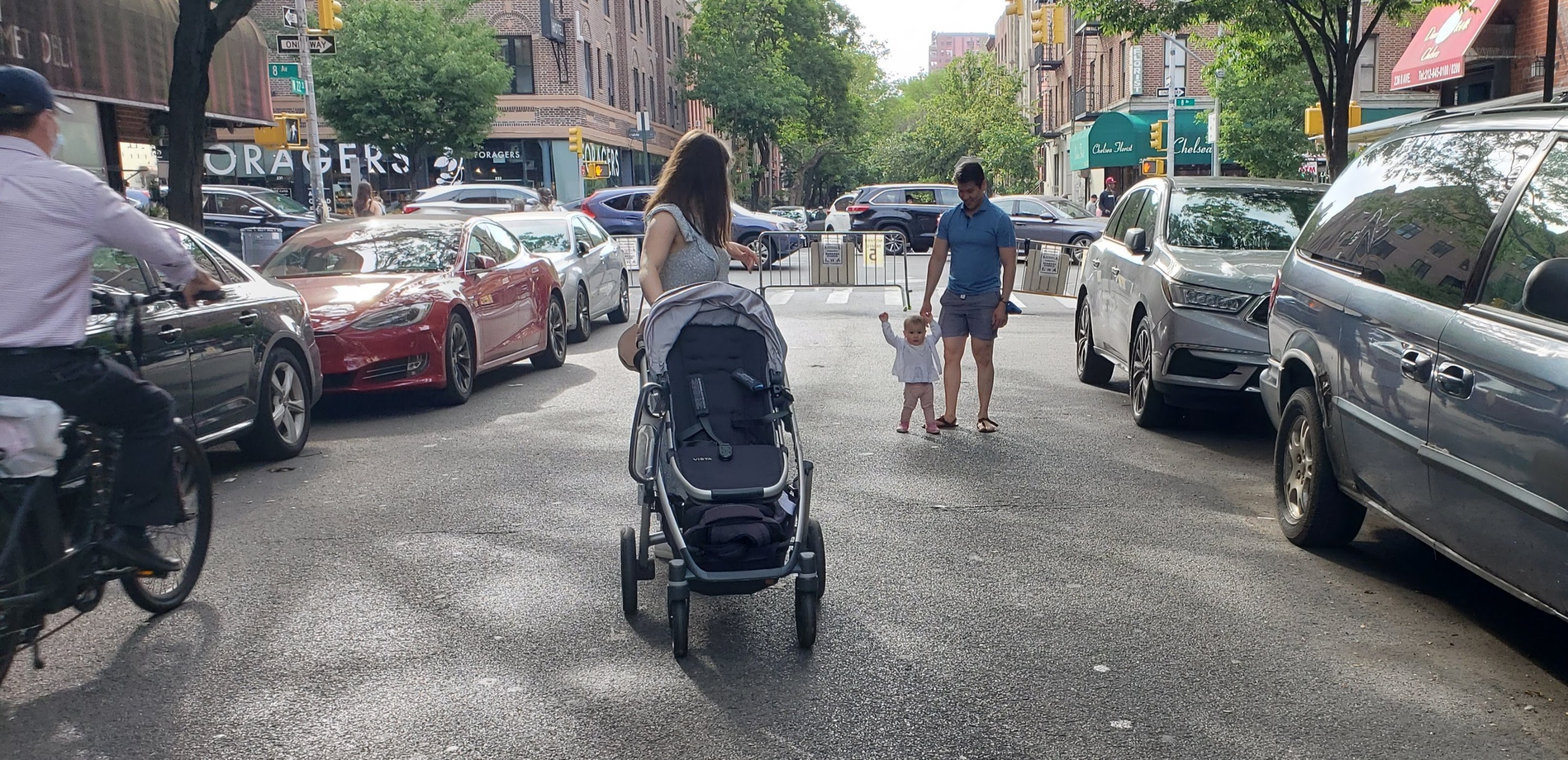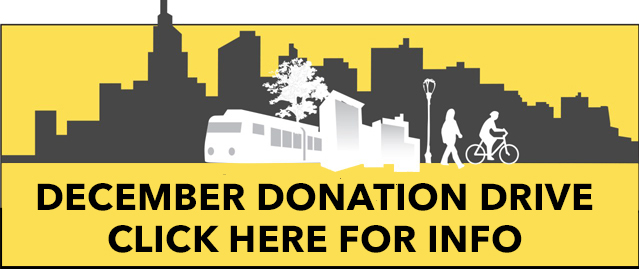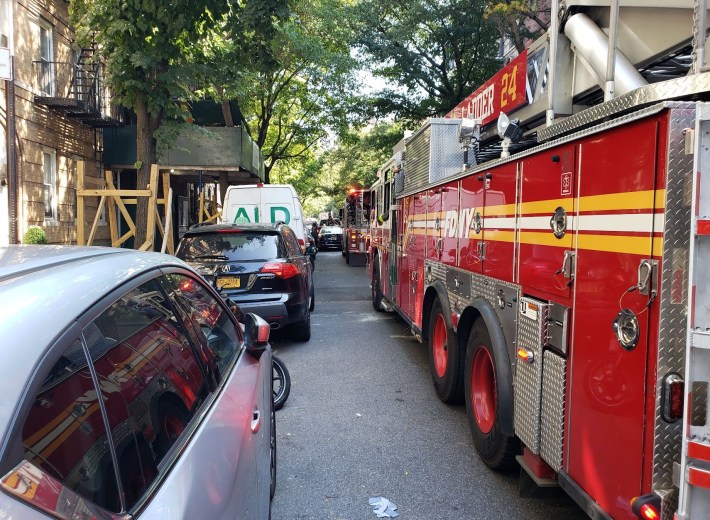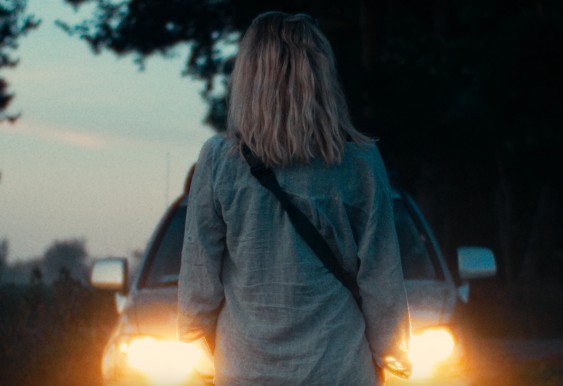W. 22nd Open Street Opponents Scale Up Backlash As City Plans Longer-term Traffic Calming
3:25 PM EST on December 4, 2022

Families enjoy the W. 22nd Open Street in Chelsea.

The city is considering long-term traffic-calming — without barriers — on W. 22nd Street as a handful of residents is trying to kill the open street outright.
The Department of Transportation, with the work of volunteers with the Chelsea West 200 Block Association, has for more than two years limited car traffic to local access at five miles-an-hour between Seventh and Eighth avenues from 8 a.m. to 8 p.m. The result, supporters say, is a roadway transformed from one choked by traffic into a quiet place for strolling, jogging, walking dogs, or teaching kids to ride bikes.
The vast majority of residents of Chelsea live car-free, DOT spokesperson Vin Barone pointed out, as he confirmed the agency was looking at designs better suited for the area.
"The vast majority of Chelsea residents regularly commute by transit, bike, or walking," Barone said. "DOT is proud to have partnered with the community on an open street that better meets the needs of the neighborhood, and we look forward to exploring design solutions that are less dependent on movable barriers."
Four-decade resident Melodie Bryant, a member of Transportation Alternatives who applied for the open street in 2020, called the entire open street effort "incredibly encouraging, and wonderful, and community building." But a band of other locals have recently started rallying against the slow zone, the Post reported on Saturday — just as civic groups and the city have begun efforts to overhaul the street's design more permanently.
The block association and the community board hosted a workshop in mid-October to field design ideas for how to make the street more accommodating for people outside of cars without having to rely on metal gates at the intersections and on people to move them.
One of the association's founders and neighborhood stalwart said she hoped the city will turn W. 22nd into a shared street, where the DOT installs bump-outs with seating, planters, and other landscaping elements to encourage drivers to pass through at slow speeds.
"The whole idea is to make life easier for pedestrians," said Pam Wolff, 87, who has lived a block south on W. 21st Street since 1956.
The street was long a favored truck route after officials widened the roadway in the 1980s and shaved three feet off both sidewalks to make way for the heavy haulers, said Wolff. That narrowed the path so much at points that people with strollers couldn't pass each other.
"It’s very constricted," she said.
The meager allocation of street space for non-drivers has long been out of synch with the neighborhood in Community Board 4, where 85 percent of households don't own a car, according to Census data. The area also had the fourth-highest traffic volumes in the city, an analysis by Transportation Alternatives and MIT found.
There is a wealth of public transit nearby, including subway lines on Sixth, Seventh and Eighth avenues, and Select Bus Service on 23rd Street.
The city has been transitioning some of the pandemic-era open streets to more permanent street redesigns, such as Paseo Park on 34th Avenue in Queens and the proposed (and delayed) bike boulevard on Berry Street in Brooklyn.
The results from the October workshop will come to the community board later this month, for DOT to consider as it draws up its plans for the street.
But at the October brainstorming session, several locals protested the open street claiming they should not have to get out of their cars to move the gates to drive east.
"It takes maybe three minutes of time [to make the detour], but they consider this an enormous burden and they are very upset about it," Wolff said. "I am a car owner, I park the car on the street. I, too, am inconvenienced by the gate, I, too, have to make a decision about whether to move [and] I choose to drive around 23rd and back on my block. It’s not a big deal."
A loosely organized group under the moniker West 22nd Street for All launched an online petition headlined "HELP STOP THE CLOSING OF West 22nd St," which has garnered more than 1,000 signatures, but advocates like Bryant slammed title as misleading since the street remains "open" to slow car traffic — only a barricade needs to be moved.
"West 22nd has never been closed," Bryant said.
Streetsblog reached out to the email listed in the petition and Joe Neuhaus, a lawyer who lives one block over, responded saying W. 22nd was a bad location for an Open Street.
"This particular block is a terrible choice. There’s no park, no restaurant, no school, nothing that attracts use. What there is on this block is a parking garage, a large indoor parking garage, the only one nearby," Neuhaus said.
Other redesigns like sections of Broadway worked because of all the businesses there, he said, but he also questioned the larger open streets program that allowed residents to request and manage traffic restrictions early on in the pandemic to give more space to pent-up New Yorkers.
"The open streets program — I don’t know a lot about it," he said. "I’m not deeply involved in city politics, but what I’ve learned about it, it was kind of a mistake, it’s kind of a dumb idea."
Moving the gates was a big issue for the hundreds of people who signed the online petition, Neuhaus said.
"It’s an inconvenience and it’s a privilege for the few people who put it in place," he said.
About a dozen opponents gathered at the barriers Friday morning for the Post's cameras and argued that they needed to be ditched as a safety hazard to emergency services (even though fire trucks were routinely stuck in traffic before the open street).

The open street's supporters agreed that the barriers were not an ideal way to manage the street in the longer term, which is why they are pushing for a city redesign that can maintain a safer road without them.
"We have a garage on this street, we’re gonna have traffic, but it doesn’t have to go through at 50 miles an hour," Bryant said.
Neuhaus said he and his fellow opponents don't want to wait for the future plans to remove the barriers.
"If you have an idea that’s a good idea, sell it on its merits and don’t sneak it through in the way it was done before, do it with public hearings and so forth," he said.
Kevin Duggan joined Streetsblog in October, 2022, after covering transportation for amNY. Duggan has been covering New York since about 2017 after getting his masters in journalism from Dublin City University in Ireland. After some freelancing, he landed a job with Vince DiMiceli’s Brooklyn Paper, where he covered southern Brooklyn neighborhoods and, later, Brownstone Brooklyn. He’s on Twitter at @kduggan16. And his email address is kevin@streetsblog.org.
Stay in touch
Sign up for our free newsletter
More from Streetsblog New York City
OPINION: Congestion Pricing Will Help My Family Get Around As We Navigate Cancer Treatment
My partner was recently diagnosed with cancer. Congestion pricing will make getting her to treatment faster and easier.
EXCLUSIVE: OMNY Debuts on Fair Fares After Delays
The long-awaited Fair Fares expansion will launch as a three-month pilot for a few dozen riders.
Good Luck Docking Your Citi Bike In Lower Manhattan
Many frustrated commuters to Lower Manhattan opted to simply abandon their Citi Bikes undocked due to the lack of open spots in the area.




